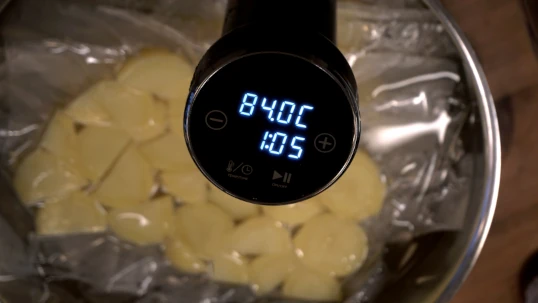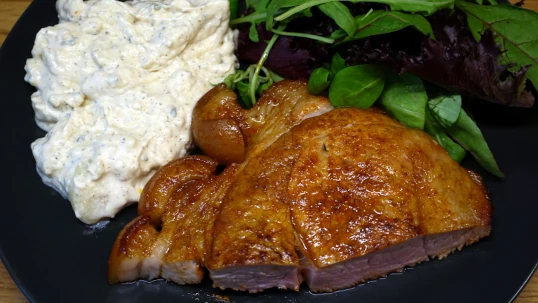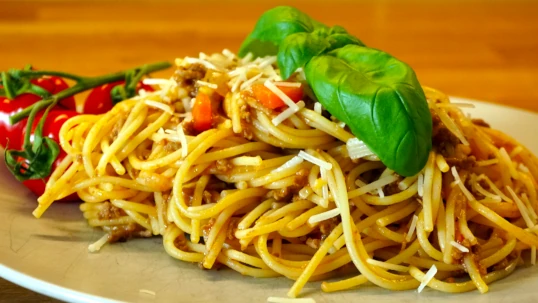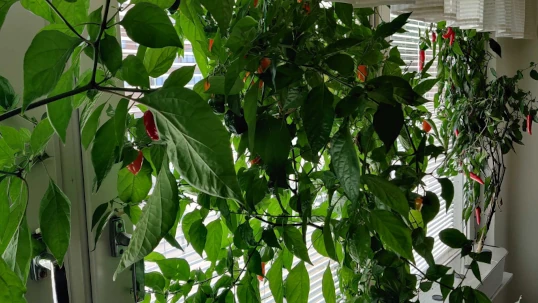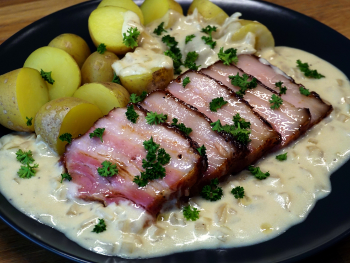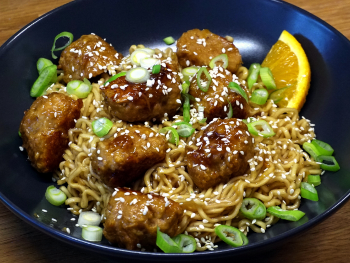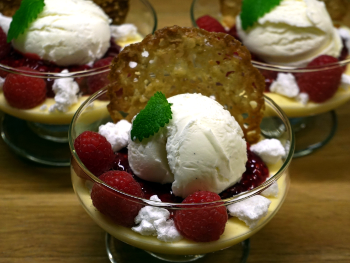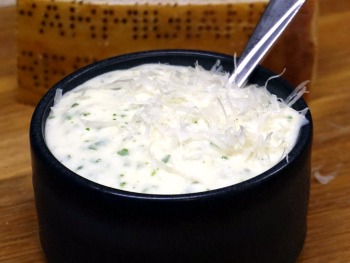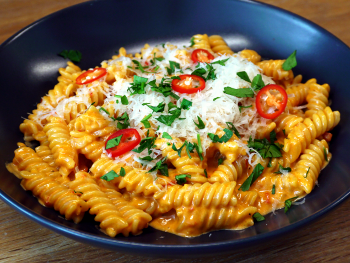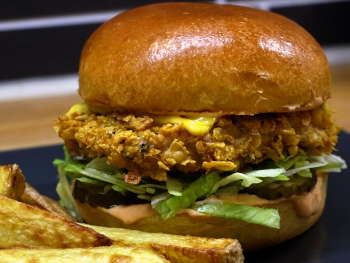Conversion table and the reason I use weight in my recipes.
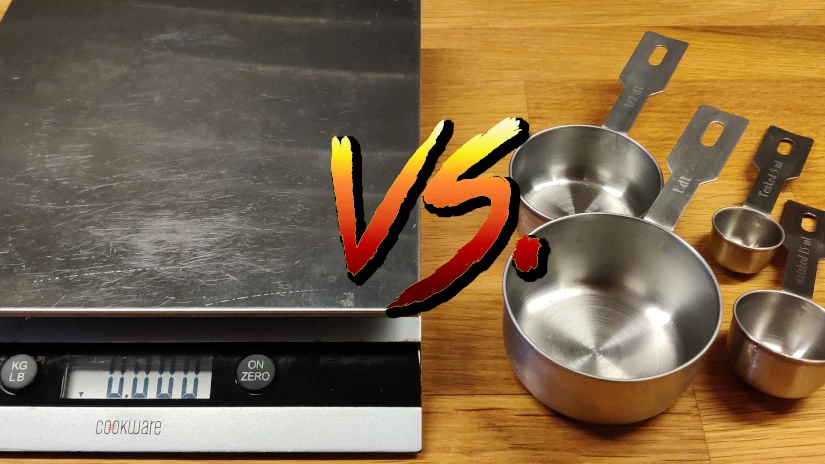
Ever since I first showed my recipe collection to some friends, I have been asked why I specify the amount of ingredients by weight instead of volume. I understand the question as many recipes have historically used volume without problems and most people who read and follow recipes are simply used to it.
However, problems arise quite quickly when using certain ingredients. Above all, it becomes clear when baking as, among other things, the amount of flour can vary very much based on who picks up a deciliter from the flour package. One thing that can make it even more confusing is the concept of "topped" where it is up to each person to decide how much extra amount of current ingredient it entails.
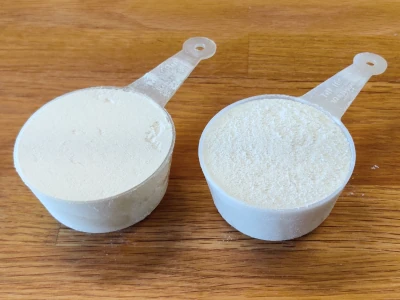 Pressed vs. powdered
Pressed vs. powdered
So I did a quick experiment where I deliberately filled a deciliter of flour in two different ways. One where I pressed the measure hard in the flour bag to get as compact an amount of flour as possible and one where I instead powdered over the flour from the bag into the measure. Because I did this consciously, I expected a bigger difference than would be considered normal, but regardless, this was the result:
- 1 dl = 82 gram
- 1 dl = 49 gram
Once again - there is a bigger difference than what a normal handling of the flour would be, but it still shows that there can be large variations in the amount that ends up in the finished product. By using a scale, you exclude this potential source of error and can be sure that you use the amount that the recipe refers to.
Website, technology and nutritional value
In addition to handling problems as above, there were also problems when I wanted my website to calculate the total nutritional value of a recipe automatically based on the ingredients included.
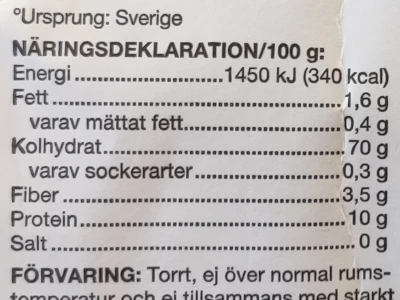 Swedish nutrition declaration
Swedish nutrition declaration
A normal Swedish nutrition declaration lists values for 100 grams and it is this information that I choose to save for each ingredient. Since I already know what the values are for 100 grams, it is easy to add up and calculate the recipe's total nutritional value based on these numbers, provided I know how much (in grams) I use of each ingredient in the recipe.
I am aware that the calculated figures for each recipe can be a bit skewed based on how the ingredients are handled. If it is a recipe that requires a long time boil, e.g. a lot of water to boil away. But that is also why I choose to show the nutritional value of the total recipe and the nutritional value of a portion.
The problem of using weight for everything arises when you instead use very small amounts of some ingredient (such as spices). A cheap/normal kitchen scale is not always so accurate that it can show parts of grams, so it is advantageous to use volume instead. Weighing up what a spice measure of an airy powder weighs is not entirely easy.
So a while ago, I supplemented each recipe with measurements in volume where possible. Nowadays, ingredients are listed according to "45 g (0.5 dl) Sugar" instead. I still use weight as the main connection and calculation in the database, but volume (or number) is now a part that hopefully makes it easier.
Conversion table
Here I list some of the most common ingredients I use and its relationship between weight and volume. There is certainly a lot missing from this list and I see it as an ongoing work that will be updated over time. In cases where I have not found an official specification, I have done my best to weigh it myself, but almost all measurements and weights on the list below are taken from the National Food Administration in Sweden or from information directly on the purchased ingredient.
| Ingredient | Weight | Volume |
|---|---|---|
| Water | 100 g | 1 dl |
| Water | 1 kg | 1 liter |
| Milk | 100 g | 1 dl |
| Cream | 100 g | 1 dl |
| Créme fraiche | 100 g | 1 dl |
| Grated cheese | 40 g | 1 dl |
| Grated cheese (parmesan, grana padano) | 50 g | 1 dl |
| Egg (M) | 60 g | - |
| Eggwhite (M) | 36 g | - |
| Eggyolk (M) | 18 g | - |
| Egg (L) | 70 g | - |
| Eggwhite (L) | 42 g | - |
| Eggyolk (L) | 21 g | - |
| Oil | 90 g | 1 dl |
| Butter | 95 g | 1 dl |
| Butter | 14 g | 1 tbsp |
| Butter (melted) | 90 g | 1 dl |
| Coconut fat (melted) | 90 g | 1 dl |
| Mayonnaise | 100 g | 1 dl |
| Flour | 60 g | 1 dl |
| Flour | 9 g | 1 tbsp |
| Dry yeast | 3.2 g | 1 tsp |
| Dry yeast | 9.6 g | 1 tbsp |
| Baking powder | 15 g | 1 tbsp |
| Baking powder | 5 g | 1 tsp |
| Potato flour | 80 g | 1 dl |
| Corn starch | 55 g | 1 dl |
| Corn flour | 60 g | 1 dl |
| Rice flour | 80 g | 1 dl |
| Breadcrumbs | 50 g | 1 dl |
| Rolled oats | 35 g | 1 dl |
| Coconut flakes | 61 g | 1 dl |
| Vanilla powder | 2.5 g | 1 tsp |
| Almond | 46 g | 1 dl |
| Basmati rice | 85 g | 1 dl |
| Brown rice | 85 g | 1 dl |
| Dry Red Lentils | 90 g | 1 dl |
| Granulated sugar | 90 g | 1 dl |
| Granulated sugar | 14 g | 1 tbsp |
| Brown sugar | 75 g | 1 dl |
| Icing sugar | 60 g | 1 dl |
| Pearl sugar | 12 g | 1 tbsp |
| Syrup | 140 g | 1 dl |
| Honey | 140 g | 1 dl |
| Cocoa Powder | 40 g | 1 dl |
| Cocoa Powder | 6 g | 1 tbsp |
| Yellow onion (medium) | 100 g | - |
| Yellow onion (large) | 200 g | - |
| Carrot (medium) | 100 g | - |
| Red bellpepper (medium) | 175 g | - |
| Red bellpepper (large) | 225 g | - |
| Eggplant | 350 g | - |
| Banana (with peel)1 | 168 g | - |
| Banana (without peel)1 | 95 g | - |
| Salt (fine salt) | 125 g | 1 dl |
| Salt (fine salt) | 19 g | 1 tbsp |
| Salt (fine salt) | 6 g | 1 tsp |
| Salt (fine salt) | 1 g | 1 pinch |
| Black pepper (finely ground) | 2.2 g | 1 tsp |
| Black pepper (coarsely ground) | 2.9 g | 1 tsp |
| Onionpowder | 3.0 g | 1 tsp |
| Garlicpowder | 3.5 g | 1 tsp |
| Chilipowder | 2.3 g | 1 tsp |
| Cayennepepper powder | 2.3 g | 1 tsp |
| Paprika powder | 2.0 g | 1 tsp |
| Turmeric powder | 2.5 g | 1 tsp |
| Oregano (dried) | 0.5 g | 1 tsp |
| Timjan (dried) | 1.0 g | 1 tsp |
I will definitely add to this list over time as it will be a big part of how I set up my recipes and calculate the amount of each ingredient. There may be older recipes that I have not updated according to these figures, so some small changes there can probably also happen.
Main sources:
www.livsmedelsverket.se
Information found on Swedish ingredients.
Own measurements.
1 Average of 10 Bananas. Big variations.
